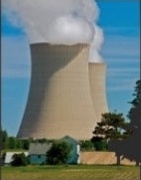By Ansar Fayyazuddin and Erik Wallenberg
Ansar Fayyazuddin is a physicist active in Science for the People and Solidarity.
Erik Wallenberg is a PhD candidate in history at City University of New York Graduate Center and Acquisitions Editor at Science for the People.
Ansar and Erik spoke with Kate on March 14, 2022.
[…]
We see that you don’t have to be a sophisticated scientist to create a nuclear weapon, but rather, you can just bomb a nuclear reactor or even just start a fire there and all of a sudden you have created an incredibly powerful nuclear weapon against the people who live close to the reactor, the very people who the reactor was meant to serve. Have people thought about these kinds of scenarios before? Are there any precedents?
Kate: Well, last week I had the same question. What are the contingency plans for a war in a nuclearized zone? Fifty-four percent of Ukraine’s power comes from nuclear reactors. I went through the IAEA (International Atomic Energy Agency) manuals and then went through some NRC (Nuclear Regulatory Commission) manuals. There’s nothing. For all the decades of designing for nuclear emergency scenarios—and we really have to hold this thought for a moment—no one thought to imagine something so human and inevitable as conventional war in a nuclear country. I mean, there have been reactors in Israel; there have been wars that Israel has been engaged in. I asked one nuclear engineer, and they said, “Well, it hasn’t really come up before,” which is an amazing response. These containment structures have been stress-tested for a big plane dropping on a reactor. But we don’t know what a direct targeted missile would do. We don’t know what heavy artillery would do. We don’t know what these super thermal weapons that the Russians have been firing—that just blow up buildings and create these really hot fires—we don’t know if these containment structures can withstand that.
[…]
Erik: Can you talk a little bit more about the current situation? I know you’re in touch with people in Ukraine and have worked with people in Belarus and Russia and all over the area. Can you give us an update on the most pressing concerns right now?
Kate: Electricity to these nuclear power installations is really a serious question. It was cut off last week to the Chernobyl zone.2 We heard this morning that it’s back on. That’s good news. So, that’s one major concern. There are four nuclear power plants and fifteen reactors that are operational. I think about four of them are running right now, maybe five, and they’re still supplying power. But if electricity to those plants gets cut off, we’re in trouble.3 The diesel generators are Russian-made. For instance, in Zaporizhzhia, Ukraine was working with a big grant from the European Union, something like sixty million dollars, to fix those diesel generators because they were faulty. COVID-19 happened and the fix got pushed back to 2023. So, if power does get cut off, chances are some of these big diesel generators that were supposed to work for two weeks without being refueled could fail. And then there are smaller backup-backup diesel generators—those that work for about 48 hours and then have to be refueled. So we see the problem. These installations take a lot of human curation and care. You need technicians who are there, who know the plants, and who know what to do.
[…]
Russians are apparently using these two captured nuclear installations like kings on a chessboard. They hold Chernobyl and the Zaporizhzhia nuclear power reactor plants, and they are stockpiling weapons and soldiers there as safe havens. This is a new military tactic we haven’t seen before, where you use the vulnerability of these installations, as a defensive tactic. The Russians apparently figured that the Ukrainians wouldn’t shoot. The Russians noticed that when they came to the Chernobyl zone, the Ukrainian guard of the Chernobyl plant stood down because they didn’t want missiles fired at these vulnerable installations. There are twenty thousand spent nuclear fuel rods, more than half of them in basins at that plant. It’s a precarious situation. This is a new scenario for us.
We’re learning that the International Atomic Energy Agency (IAEA)—I reported on this in my Chernobyl book—is not a very good watchdog for nuclear safety. They don’t have the power to do anything during this war, and that’s not necessarily their fault. But they don’t actually have the political unity or will right now to act. The Russian diplomats have a privileged position on the IAEA Board of Governors. They have not stepped down. They’ve not been asked to leave. So any statement that IAEA makes is a statement that’s somewhat mediated through Moscow. When they say, “power has been cut off at the Chernobyl plant, but there’s no problem, that fuel is too old to boil and burn,” I am skeptical. I checked the NRC (Nuclear Regulatory Commission) pamphlets, and they say there’s really no way to properly calculate the age and the rate of heat of this spent fuel. We noticed last year that there was a strange surge of radioactivity coming from inside the sarcophagus at the Chernobyl plant. Nobody knows why. When I asked my friend—who’s the employee there, and he’s sitting next door in the town of Slavutych—about the IAEA statement that there’s nothing to worry about power cut to the Chernobyl station, he said, “That’s fine if you’re sitting in Vienna, but here, I’m worried.” This guy is pro-nuclear. He’s as cool as a cucumber, but he’s starting to get really worried.
[…]
Erik: Let’s continue on this question of “why nuclear power” even after the tragic case of Chernobyl. Some climate justice activists, and certainly many politicians and the nuclear power industry, tout nuclear as a clean energy source. At the very least it’s held up as a bridge to renewable energy. Infamously, after the Fukushima disaster in Japan, The Guardian columnist and environmentalist George Monbiot said he was even more confident that nuclear power is a safe energy option. Can you talk about this argument and how you see it, especially given the crisis of ongoing wars, which we’re guaranteed to continue to have in this world and the future certainty of instability with the climate crisis?
Kate: I think the only reason Monbiot can make that statement is in the face of severe minimization of the impact of accidents like Fukushima and Chernobyl. You know, if the Japanese had the same minimum safety standards that the Soviets had applied in zoning of Chernobyl then they would have a huge territory depopulated. But they chose to do a cost-benefit analysis that sacrifices the bodies of people who live in the Fukushima province. If you think that 35 to 54 people died in Chernobyl, then yes, nuclear power is worth the risk. People say, “The world’s worst human-made nuclear accident and only 54 people died.” But the count in 2016 that Ukrainian officials were giving was 150,000 dead just in Ukraine alone, and they had only 20 percent of Chernobyl’s fallout, with 80 percent went to Belarus and Russia. Those countries have not been brave enough to publish any records about the public health impact. Now we’re starting to look at hundreds of thousands of people killed from this accident. And I think if we were to face the reality and the long-term impact, not just what happens when a body gets zapped in a nuclear detonation, then we would rethink this.
I would sleep better right now if Ukraine was chock-full with solar power and wind generators. In a war there might be toxic waste spread around those places from the batteries, but then you could clean them up. That’s not true with somebody hitting a nuclear installation. The toxins last for centuries.
The reason why nuclear power is so popular with certain parties is because it requires the least amount of changes to our economic structures, to our distribution of [political] power, and distribution of wealth. So if you have centralized corporate control of a power system, whether it’s by owning the gas fields or by owning a nuclear plant, then you can still command the prices you want. You can still dictate who gets what [electric] power and where. If you have distributed decentralized forms of energy generation like solar and wind supply, then you redistribute political power, you redistribute economic power. And it would be really hard for the Russian armies to capture all those solar batteries and solar panels throughout the country. That makes turning off the lights an impossible job.
So, nuclear power doesn’t make sense.
[…]
Ansar: The often quoted zero death toll of Fukushima has become this statistic that people throw around. The same was true with Chernobyl before your book—everybody talked about what turned out to be a fabricated statistic of a low death toll. And then you showed that tens of thousands of people were killed as a result of Chernobyl. There is a certain laziness about the statistic because it hides the real tragedy. In Fukushima, the displacement of so many people is not treated like a tragedy; only deaths qualify. In the case of Chernobyl, Svetlana Alexievich recorded the human tragedy and it is just so striking: displacement, illness, ostracization, loss of community, living with the fear of the consequences of exposure to radiation, and so much more.5 Selecting a particular statistic can serve a certain rhetorical function. So, should we be trying to find a different measure or should we be concerned with emphasizing qualitative ways of thinking about the consequences of nuclear accidents?
Kate: Yeah, I think you’re right. I like the way you put it, Ansar. There’s a sort of laziness of coming to terms with these tragedies, with the idea that we just want a death count. Or maybe we want to count cancers? What I found, working in these different post-nuclear sites where people were subjected to radioactive contaminants, is that the quality of life declines. Before people get cancers, before they die of these cancers, they get sick in other ways. They just feel crappy. In Chernobyl they reported that their throats were sore. And then everybody comes down with some kind of bronchial pneumonia or something. They can’t get rid of it. Their immune systems are shot. The radiation they imbibe goes down to the digestive tract, and they have trouble digesting their foods. They don’t feel very peppy. They develop chronic fatigue. Kids are keeling over in schools with these strange nosebleeds. Ambulances are parked out front in the schools. Parents are worried sick because their child isn’t acting like a child or an energetic, joyful young person.
[…]
Yuri Bandazhevski, a medical doctor, a pathologist, was arrested and thrown in jail by Belarusian President Lukashenko’s police forces for investigating health effects in southern Belarus, in Gomel. After he was released, he took a little break in France and then opened shop in northern Ukraine. And he’s still sitting there because he didn’t want to leave his patients, and he’s surrounded by that Russian convoy. He’s in the town of Ivankiv, which is the first town outside of the Chernobyl zone that the Russian convoy, standing sixty kilometers long, now occupies. He finds that people live fifteen years shorter lives in his county. He’s been conducting research there since 2006. The kids have a host of chronic health problems and the long term projection for their health isn’t very good. These are the kinds of health problems people face that are easy to dismiss because they’re fuzzy, because they’re not something frightening like cancer. But having multiple organs in one’s body function poorly and feeling crappy all the time is awful—worse yet to be dismissed as hypochondriacs, radio-phobic, or neurotic. But once that scenario enters your life, in your family and your community, the multi-generational illnesses take their toll.
[…]
You need something like thirteen pounds of plutonium to make the core of a nuclear bomb. To get those thirteen pounds of plutonium, you start with a couple of hundred tons of uranium. The difference between a couple hundred tons and that a softball-size plutonium core is all radioactive waste. And what did they do with that waste? It went up the stacks in the form of gas. It was dumped into the Columbia River. It was buried in what they called reverse wells, which were just holes in the ground, and poured into the groundwater. The high-level waste they put in these underground storage tanks that were supposed to last for just ten years. They’re still there. Some of them are leaking. They cannot solve this problem. It’s been a Superfund site since the early 1990s.6 They’ve spent over a hundred billion dollars, and they can’t fix the problem with the high level of waste. They put the project on ice for now because they can’t figure out how to fix it. They were just throwing money at these contractors, the same contractors by the way, that created the problem in the first place.
[…]
These civilian reactors are basically repurposed military reactors. There are two different kinds. One comes from a nuclear submarine and another comes from this Hanford-style plutonium generating reactor, called dual-purpose reactors. The Soviets copied those same two models, and that’s what we have. There are about eight different reactor types around the world. All came from military design. So, those two, military and civilian, were born as twins.
Not long ago, I was looking at the average exposures of Americans who were born in the 1950s, at their exposures from just radioactive fallout from the Nevada test site. I realized that the average American got a larger dose of radiation than the average Chernobyl liquidator—I mean, just an astounding number!7 Children have gotten higher doses than adults. They were going out to play in the playground at their schools and obediently drank their milk as parents told them, and they were getting doses that were higher than Chernobyl liquidators who willingly and altruistically went to work to liquidate the aftermath of the disaster. The northern hemisphere of the globe in particular is saturated with radioactive fallout. Some of it was short-lived radioactive iodine. But the other elements—cesium, strontium, plutonium—are here with us for a long time, and we live among them. And we see likely health effects. In the northern hemisphere since 1945, male sperm counts have dropped in half. Rates of thyroid cancer are growing. Gastric cancer grows at six percent a year. Rates of cancers among people born after 1952—that’s when the big bombs started to blow, the big hydrogen bombs that spread so much radioactive fallout—are on the rise. This correlation between nuclear fallout and these troubling health statistics is something I think we should get more curious about.
[…]
Ansar: There seems to be a shift away from ecological ways of thinking about the environment and towards an emphasis on physical mechanisms. So, for instance, we talk about carbon dioxide percentages in the atmosphere as the primary problem. The problems formulated in this way immediately suggest technical solutions like nuclear power or geoengineering. We don’t really think about the effects of this on the broader ecology and the interconnectedness of living beings. It’s then easy to miss the consequences of these “solutions,” which address that one number but forget about the outcomes for everything else.
Kate: Yeah, you know, here I am at MIT and I worry. I worry about solutions presented and proposed by the very same people who got us into this fix in the first place. I mean, we all got ourselves into this fix. We’re all happily consuming away, wanting to increase to better our lot. But the technologies that brought that about are coming from these people who are now offering solutions, and they are solutions that point towards one fix: ways to get rid of the carbon dioxide. We need to think about more organic changes. And those changes come from all kinds of creative people in society that are happening all the time and they don’t necessarily have credentials behind their names. Britain for instance—this argument just came across my desk—had they just continued with the plan to make houses more efficient, they wouldn’t be needing any Russian gas right now. They wouldn’t be feeling any pain from cutting off Russian oil supplies. I’m engaged in a project right now that looks at working-class urban people who, in the long twentieth century used urban spaces and the extraordinary wealth of organic matter that flows into cities to grow food. And they grow incredible amounts of food, two to three thousand tons on a tenth of an acre in a season. All done using waste products, waste streams, and recycling them, restoring the metabolic rift that cities created; not having all that stuff go out into local rivers and into the ground as garbage. And I think this story has been overlooked because the people doing it were often people of color: they’re working-class. They created absolutely amazing technologies; they were low-budget technologies and that wealth of knowledge, and those innovations were distributed widely and there was no single entity there to capitalize on it, patent it, and capture it. I think that those are the kinds of solutions and those are the kinds of problem solvers we should turn to.
[…]
Read more.




